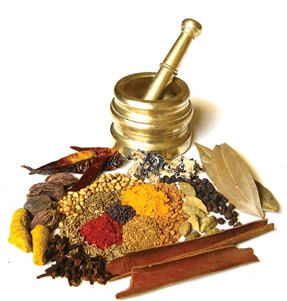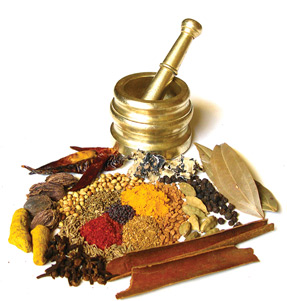Life
Healing With Desi Food

Health benefits of common herbs and spices in the Indian kitchen.
|
Indian food is rich in herbs and spices, which are relished for their flavor, aroma and texture. Here’s a lowdown of some of the health benefits of common herbs and spices in your kitchen.
1. Cloves (Lavang): Cloves are stimulating and have antibacterial, antiviral, antifungal and antiseptic properties. Due to the presence of Eugenol oil and beta-caryophyllene, they also have powerful anesthetic value. It is a digestion promoting spice. In some cultures, it has been used successfully to treat scabies, cholera, malaria and tuberculosis. As an antispasmodic it can be applied topically to relieve muscle spasms or in a tea to ease coughing. Lastly, it also contains a Kaempferol and Rhamnetin, which also contributes to the clove’s anti-inflammatory properties.
2. Fennel (Saunf): Fennel seeds help with respiratory complaints and soothes coughs in general. Almost the entire plant is used in cooking. It is rich in phytoestrogens and helps in colic, wind, irritable bowel, suppressing appetite, breast enlargement, promoting menstruation, kidneys, spleen, liver, lungs, improving the digestive system, and milk flow. In addition, fennel also helps restore digestion in post-chemotherapy patients. 3. Ginger (Adrakh): The chemical Gingerol present in ginger soothes nausea and an upset stomach. It is also a very effective digestive, anti-phlegmatic and anti-pyretic agent and has strong anti-inflammatory properties. For this reason it helps seniors with arthritis and those who suffer from migraines (as it also inhibits prostaglandins). Zingerone present in ginger helps curb diarrhea in infants. It is also available in the form of ginger oil or pills. Like garlic, it prevents colds and flus. Ginger teas are advisable during the winter season. Recent lab testing shows ginger’s tremendous powers to control ovarian and colon cancers. 4. Garlic (Lehsun): In the season of flus and colds, garlic is a preventive agent through its chemical Allicin, an antibacterial and an antiviral agent. It is common knowledge that garlic also helps lower tryglycerides (LDL or bad cholestrol) in your blood thus indirectly helping reduce chances of heart attacks. However, keep in mind that though garlic serves as a natural and powerful antibiotic and a blood-thinner, which is beneficial for hypertensive populations, it has the potential to disrupt anti-coagulants in the body and is best not taken before surgeries. 5. Coriander Leaves (Dhaniya): Coriander is packed with phyto-nutrient content such as Carvone, Geraniol, Limonene, Borneol, Camphor, Elemol and Linalool giving it its antibacterial property. Thus it lends itself as a natural fighter against Salmonella, skin diseases, diarrhoea etc. This herb also contains Citronelol, which helps against mouth ulcers and serves as an antiseptic. Apart from this, the aromatic coriander contains Linoleic acid, Oleic acid, Palmitic, Stearic and Ascorbic acids that help reduce the cholesterol level in the blood. Among one of the other major benefits is Cineole, an essential oil, and Linoleic acid, present in coriander that possess anti rheumatic and anti arthritic properties. Coriander is a rich source of magnesium, Manganese and Iron as well as Calcium and Phosphorus. 6. Asafoetida (Heeng): You may be preparing daal/lentil soup, dosai with a pinch of asafoetida. Know that it is a carminative and an anti-flatulent as it promotes health of the gut flora. It also possesses strong antimicrobial properties and is thus used in the treatment of cough and bronchitis. It is an abortifacient and should be avoided by pregnant women. The oleo-gum-resin of Asafoetida has antiepileptic properties. Scientists in Taiwan’s Kaohsiung Medical University found a compound in Asafoetida that is potent to kill the swine flu virus. The researchers said the compounds “may serve as promising lead components for new drug development” against this type of flu. 7. Turmeric (Haldi): The bright powder is an excellent source of Vitamin B6, Iron, Potassium and Manganese. Research conducted at UCLA, published in the Journal of Biological Chemistry (December 2004), establishes the mechanisms behind Curcumin’s protective effects against Alzheimer’s disease. Turmeric is also a powerful anti-fungal and anti-bacterial root that double sups as an analgesic and anti-inflammatory agent. Researchers have also indicated that the presence of the chemical Curcumin makes turmeric a powerful cholesterol-lowering product. It is also a good source of pyridoxine which keeps homocysteine levels low (in turn reducing the risk of artery damage, heart disease etc). Turmeric is a proven preventative for colon, prostrate cancers and leukaemia in children. Curcumin also helps the body destroy mutated cancer cells. This chemical also makes turmeric a very powerful antioxidant neutralizing free radicals in the body.
8. Cumin Seeds (Zeera): This unassuming spice is an excellent source of Iron and Manganese and helps digestion. Cumin’s potent free radical scavenging abilities strengthen liver’s detoxifying enzymes making cumin a good cancer preventative agent. 9. Fenugreek Seeds (Methi): A 6-month trial was conducted on people who were given 2 ounces of fenugreek a day. Results at the end of the trial showed cholesterol reduction by as much as 15%, reducing the chances of heart attack by 25%. Fenugreek is a proven remedy for improving digestion, reducing heartburn and skin inflammation. 10. Whole Pepper (Gol Mirch): The sharp whole pepper we use to temper our dishes is a good source of Vitamin K and Iron. It is an effective carminative. It promotes the production of hydrochloric acid in the stomach and thereby proper digestion of ingested food. Another interesting quality is its ability to promote the breakdown of fat cells. Whole Peppers are hasdiaphoretic (promote sweating), and diuretic (promote urination). Not the least, Black pepper is an antioxidant and posseses antibacterial properties. Mamta Singh is a certified fitness instructor and sports nutritionist. |


